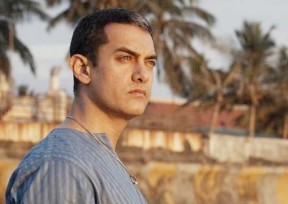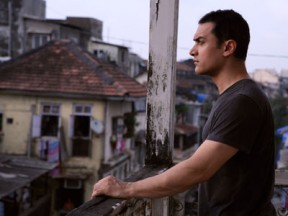On Aamir Khan’s birthday today..we look back at one of his milestone productions..Dhobi Ghat…
There is a moment in Basu Bhattacharya’s Anubhav when from a penthouse where the film is set (owned by Tanuja in real life), you see Mumbai or Bombay as it was in 1970s, waking up to a lazy dawn. There is the signature morning tune of All India Radio in the backdrop. Streets are being swept, birds are searching for food. It is just a spontaneous reference to a life that the protagonists residing in the sprawling penthouse full of servants do not experience.
It is a moment that subtly sums up the distance between the hollows and the peaks of a city. But even if you don’t see the economic subtext, what you remember is the time taken by the director to engage you in a moment that a lesser film-maker would have missed.
Then there was Ray whose Charulata spends a long moment looking out of a series of windows through a set of binoculars at listless street life.
You remember the sense of ennui the scene breeds in you. You also remember the swing that does not take Charulata but you to a point somewhere near the sky. The camera not just captures the motion of the swing but also miraculously evokes the invisible yet palpable release felt by a woman whose life never peaks. There are many moments in Ray’s films where objects speak, windows and curtains sigh, the loose door of a glovebox in the car dashboard rattles to create a sense of movement.
The opening scene of Kiran Rao’s debut film Dhobi Ghat (Mumbai Diaries) immediately takes you back to Ray and Bhattacharya and refreshes a certain kind of filmmaking, now almost extinct. Filmmaking that is about nuances and layers and pauses that tell you, “Don’t miss that!There is a story in that rain drop.”
A certain breed of film critics today, instantly attributes anything out of the box to a European sensibility. A marathon session with just Basu Bhattacharya and the excruciatingly slow burning Mani Kaul will tell them that Dhobi Ghat is not a radical departure but a worthy successor to what Ray, Ghatak, Mrinal Sen and many others created.
Back to the opening scene. We hear voices in a taxi, the standard conversation between the driver and the passenger about the native place they have left behind to come to Mumbai. We hear snatches of a vintage film song and catch just a glimpse of the taxi driver. A playfully swinging bunch of wax grapes inside and fleeting shots of marine drive outside create a texture that is less cinema and more life. Like our senses that randomly fixate on sounds and images and create our own mental montages, Dhobi Ghat is more about perception than narration. And then there are the questions. Does the story fit into a city or does a city fit into a story or if the city is the story in the film is hard to tell. The film is more like a watercolour study of a megapolis where streaks and droplets of colours blur into pools of water and boundaries between lives, lanes, buildings merge. Rao though frighteningly gifted is no Ray however and her gaze and her smile of recognition as she surveys the city is warmer than the heart of her story. Dhobi Ghat is beautiful beyond words and not in a limited aesthetic sense. It is a smorgasbord of stimuli in the way it juxtaposes many many Mumbais and four lives. The film flits between rainwashed sea facing terraces and dripping tarpaulin roofs of cramped hovels, between the glimmer of hope and the wince of wistfulness and traces of unfulfilled promises.
Lingering on faces and locations that never seem to be aware of a camera, Dhobi Ghat bravely stalls today’s adrenaline drunk audience and coaxes them to peer into distant windows and teases patterns on a blank canvas. It lets us bite into ripe, succulent moments and replete silences but it does not let us feel too much for any character. And that is its only flaw. There is Shi, an investment banker on a sabbatical and her only conflict is whether she should let go of the unfinished business between her and a painter with whom she had a fleeting encounter. Monica Dogra’s Shi is effortlessly luminous and her friendship with a young, vulnerable Munna, a dhobi, rat killer and wanna be star rolled into one has its moments. But it is only in the climax when Munna runs behind her car to give her back a piece of her life, that you almost feel a wrench and a gasp of something close to an emotion. But only just about. And if a story cannot make you feel for its protagonists, it is lacking something vital. So is Rao a better observer than a story teller? We will have to wait for her next film to find out.
Prateik Babbar’s Munna is the only character who develops enough to make you care for him. Whether he is striking a pose for the camera or protecting Shi from a liftman’s gaze or from a crowd, there is something sweet, lost, raw and awfully moving about him.
Arun, the painter played by a beautifully polished Aamir Khan in floaty linen shirts and with a sublime tuft of grey is the most underdone character of the narrative. He develops a flicker of emotion only when he is sucked into the video diaries of a woman whose innocence and joie-de-vivre slowly spiral into dark hopelessness. Other than his fear and grief when he confronts a tragedy, he is singularly monophonic. We see him inhabiting his house in utter isolation, speaking over the phone, cooking, painting and occasionally interacting with Shi and Munna but unlike his neighbourhood, he has no stories to tell. He is a prop, almost inanimate that the city and Yasmin of the video diaries tell their stories to. The few lines he speaks are weaker than his silences where we see his remarkable face at almost tactile distance, frowning, amusedly smiling, lost and brooding.
Then there is Kriti Malhotra as Yasmin, packing in the confining gaze of a video camera, a lifetime of hope and misery. It is a compelling cameo and a story told with great attention to detail evoking the longing for mangoes from home, thwarted joy in a relationship devoid of any human connection in a setting where a camera becomes the only companion. Yasmin’s story is poignant and haunting in its disconnectedness from every other character in the film and makes you realise that in its totality, Dhobi Ghat is not so much about closure as about continuity. Arun will keep changing homes.
Munna will go on despite losing his innocence to a tragedy and the loss of a love that never was. Shi will continue longing for a man who attributed his fleeting passion for her to alcohol. Or maybe not. Maybe she will just crumple his memory and throw it away. Another Yasmin will arrive in Mumbai with hope and longings. And Mumbai will keep pulsing, throbbing, absorbing, listening. There will be rain shuddering against windows. There will be lives changed, cut short, enriched and there will be Dhobi Ghat, where clothes are washed clean of stories and refreshed to take on wine stains, tears and the grime of everyday living. Through paint on canvas, a camera capturing Mumbai’s unlit lives, a video camera speaking of an unfinished life and Gustavo Santaolalla’s music, Dhobi Ghat in the end tells us more about a city than those who inhabit it. Yet, it is one of the most stirring films in recent times because it savours the unspoken, the ephemeral and evokes in us if not sweeping, grand emotions than subliminal responses to a life we have not registered in a long time.
Reema Moudgil is the author of Perfect Eight (http://www.flipkart.com/perfect-eight-9380032870/p/itmdf87fpkhszfkb?pid=9789380032870&_l=A0vO9n9FWsBsMJKAKw47rw–&_r=dyRavyz2qKxOF7YucnhfXw–&ref=4fe1efd1-de20-4a30-8eb8-ef81a99cb01f








Lovely writing 🙂